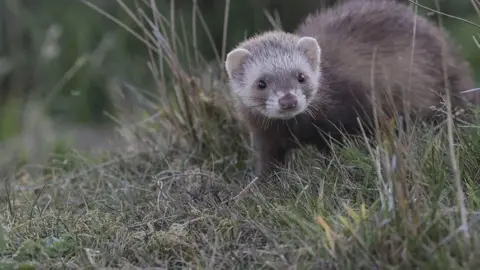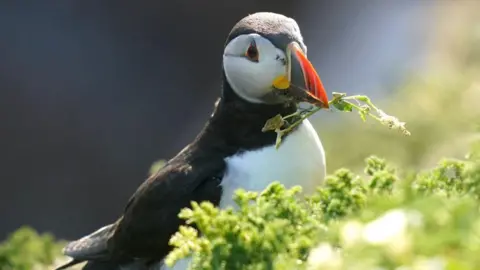Conservationists hopeful over Rathlin ferret removal
 Tom McDonnell
Tom McDonnellConservationists working to protect Rathlin Island's at-risk seabirds are hopeful that they have rid the island of its invasive ferret population.
Launched in 2021, the five-year £4.5m the LIFE Raft project, which runs until the autumn, has been working to eradicate rats and ferrets from the island off the north coast.
Now the Royal Society for the Protection of Birds (RSPB), who run the project, have said they are "optimistic" the ferret population on Rathlin has been eradicated.
"To date, there has been 98 ferrets caught, and from November 2023 there have been no confirmed ferret sightings," the project's fieldwork manager Michael Rafferty told Causeway Coast and Glens council earlier this week.
Mr Rafferty said, in terms of tackling ferret numbers, it had gone well and "things are looking good, although it's not confirmed that the ferret is eradicated yet".
 PA Media
PA MediaRathlin Island is only six miles wide and one mile long, with a population of about 150 people.
It is internationally renowned as home to puffins and other seabirds including razorbills, kittiwakes, Manx shearwaters, guillemots and fulmars.
But bird numbers had been in decline over recent years, sparking fears among conservationists.
Both ferrets and rats prey on the eggs and young of the vulnerable bird species which use the island's cliffs for breeding.

Mr Rafferty told councillors ferrets were possibly introduced in the 1980s to control rabbit numbers, and since then had done "tremendous damage to ground-nesting birds".
"In just a few days one adult ferret managed to kill 27 adult birds, just by gaining access to a puffin colony," he said.
The team behind the LIFE Raft project have deployed traps and a detection dog in efforts to control ferret numbers.
 Getty Images
Getty ImagesEfforts to tackle the brown rat population were started in September last year, he added, and that is "ongoing".
The £4.5m LIFE Raft project is funded by EU LIFE, National Lottery Heritage Fund, Garfield Weston Foundation and DAERA.
